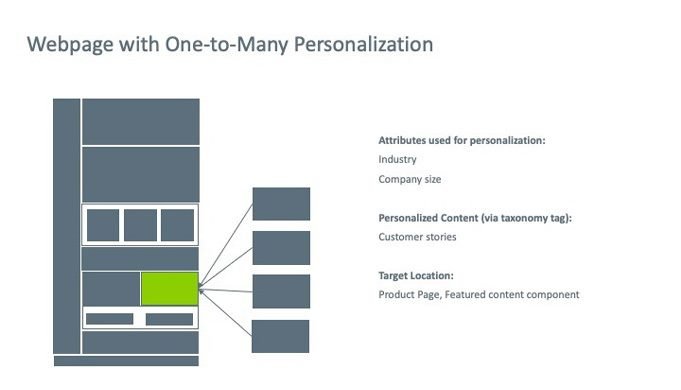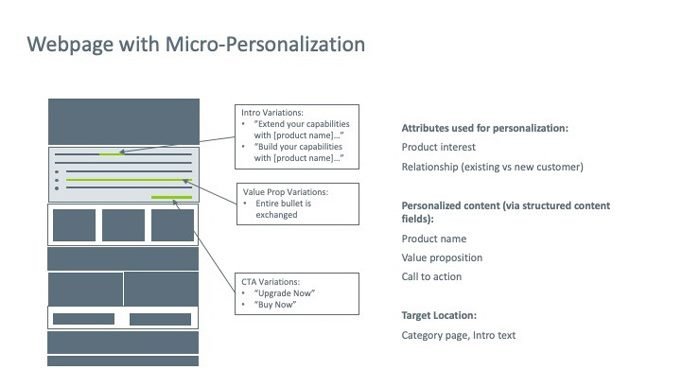This post originally appeared on CMSWire by Lindy Roux, Tendo Communications Executive Vice President and Partner.
For a digital marketer, there’s only one thing more frustrating than delivering the wrong message to the wrong audience. It’s delivering the wrong personalized message to the wrong audience. Because you invested time and money in marketing personalization and your efforts still missed the mark.
But were you targeting an individual person or just a broad demographic, like Baby Boomers? An IT consumer interested in a specific solution or anybody who works in IT?
That’s the problem. Personalization often isn’t personalized enough. Most marketers push one-to-many personalization strategies when what they really want — and what customers desire and expect — is one-to-one personalization: content tailored to individuals’ needs and interests. We all want to be like Netflix, which miraculously knows that I enjoy English dramas with a strong female lead.
So how do you achieve this level of personalization? To scale one-to-one or micro-personalization for your business, you must first evolve your content strategy: Set up structured content and a taxonomy within your digital experience platform (DXP), enabling you to deliver far more targeted, relevant content.
In the first article of this series on structured content, I explained how structured content can unleash your omnichannel strategy. Now I want to explore its applications for micro-personalization.
Quick disclaimer: This article focuses on how to structure and deliver personalized content. The other side of this coin is data management: the data fields, algorithms and automations that power personalization. That’s an entirely separate topic that we will not cover here.
Step 1: Define Your Audience Needs and Personalization Attributes
Micro-personalized content starts with understanding your target audiences. Who are they and how did they find you? What are their specific needs and interests? What content will capture their attention and engage them meaningfully? The answers to these questions will help you compile a list of audience attributes for personalization.
Common attributes for personalization include company size and industry, which might allow you to personalize a webpage with a relevant case study or piece of thought leadership. But we want to get far more granular with attributes such as:
- Education, profession or title.
- Company name, if appropriate.
- Level of technical expertise.
- Interest in a specific product or solution.
- Point in the purchase journey.
The data available to you can be overwhelming, so choose only the attributes that help you achieve meaningful personalization. Nevertheless, you’re building a snowflake: When you combine different attributes you suddenly have an individual person to engage. For example, you can serve content specifically for an IT senior director from Company X who searched on “hybrid cloud solutions” to find you and is repeatedly visiting your website to compare your solution with other vendors.
But don’t worry. You won’t have to manually create 100 permutations of a webpage to speak to these individual audiences. A well-designed taxonomy, structured content, and personalization rules will perform the heavy lift.
Step 2: Set Up a Taxonomy and Structured Content Fields
Your DXP or CMS should already have a detailed taxonomy in place, otherwise you’ll never reap the full benefits of these advanced platforms. A taxonomy is a vocabulary of terms grouped into categories, subcategories and tags, all of which help you organize your content — web pages, digital assets, images, page components and more. Does your existing taxonomy support the personalization attributes you want to use? Review it and make adjustments as necessary.
A taxonomy will help you serve content dynamically to achieve one-to-many personalization. But for the micro-personalization I’m describing, you’ll likely need to set up a series of structured content fields within your content platform. “Structured” content is organized and separated into its individual component parts. For example, the headline, description, and call to action for a content feature would be entered into separate structured content fields on the back end of your DXP or CMS.
Think of structured content as Lego blocks that can easily be reassembled and repurposed based on the personalization attributes you created. So instead of writing two dozen customized paragraphs at the top of a webpage — each speaking to the needs of a different visitor — you can instead set up structured content fields to dynamically personalize individual content blocks, sentences or keywords.
With a rich taxonomy and structured content in place, the third step of micro-personalization is to set up the dynamic triggers and personalization rules (e.g., “If condition X is met then perform action Y”) within your technology platform. It’s best to start simply and then incrementally add more rules and content permutations. You’ll gradually gain confidence with how to execute personalization and leverage structured content.
What It Looks Like: Micro-Personalization vs. One-to-Many Personalization
Structured content can feel conceptual until you see it in action. Review the two product webpage examples below. The first deploys a one-to-many personalization approach, swapping out the customer case study based on the recognized industry of the visitor. All the other page components and text are static.
The second webpage achieves a much more detailed level of personalization. Thanks to structured content fields, the page can personalize product names, value propositions and CTAs based on the visitor’s attributes. In this way, the visitor benefits from a much more compelling and relevant content experience.


Personalization Begins and Ends with Content
Many marketers struggle with personalization and lack confidence in their personalization strategies. Let’s be real: Personalization isn’t easy. It requires a sizable commitment of time and resources. And while technology platforms continue to expand capabilities and incorporate sophisticated artificial intelligence (AI), success still begins with a focus on content.
As my friend and peer Jeffrey MacIntyre says, “think IA before AI.” No matter what technology platform you choose, you must first devise a solid information architecture (IA) to organize and structure your content. That takes a bit of elbow grease, but your efforts will open the door to a new level of personalization for your brand — and create a rich and relevant experience for your customers.










